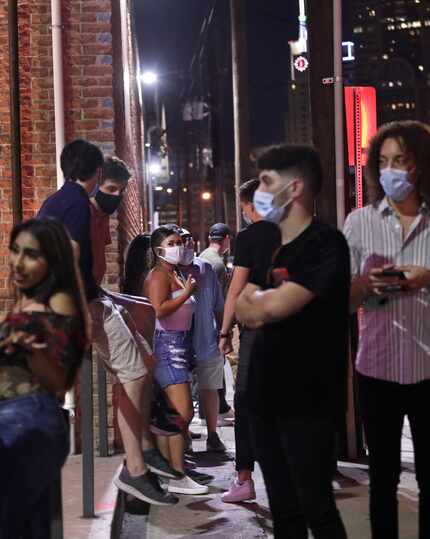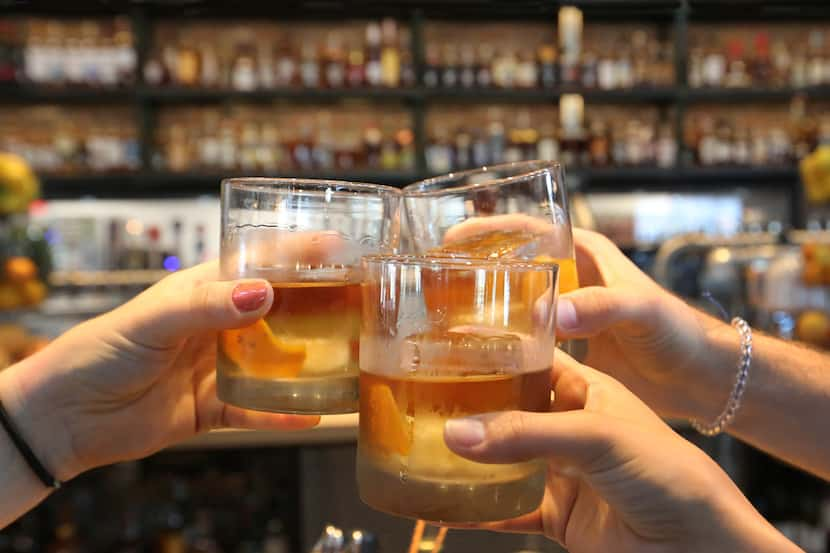More than 10 weeks after Gov. Greg Abbott closed bars across Texas comes good news: Public health officials say the strict safety standards used to fight the spread of the new coronavirus are working.
“We have seen a decline in cases, and we’re starting to see a decline in deaths,” says Dr. Erin Carlson, associate clinical professor and director of graduate public health programs at UT-Arlington’s College of Nursing and Health Innovation. “We are officially in a better place, by public health standards.”
But — and with coronavirus, there always seems to be a “but” — the three experts interviewed for this story say it isn’t time to change our behavior. Even though Dallas County lowered its COVID-19 threat level on Sept. 2, the county guidelines do not recommend that Dallasites go inside bars right now. Our three experts agree.
“COVID has not changed. We have changed,” Carlson says: We’ve started wearing masks, we’ve limited our exposure to public places with crowds, and we’ve gotten more careful about washing our hands and disinfecting surfaces. “If we go back to our pre-COVID ways, of no masks and touching ... we are going to see a massive spread. We must remain vigilant and consistent.”

That’s unwelcome news for the thousands of bar owners whose doors remain locked. Bar owners across the state have filed lawsuits, hosted protests and even purposefully disobeyed the rules, under the belief that bars were unfairly targeted in Gov. Abbott’s June 26 mandate that forced their closure. As of Sept. 8, just over 650 bars have been able to reopen after securing a special “food and beverage certificate” from the Texas Alcoholic Beverage Commission (TABC).
“It’s great that we’re seeing fewer cases, but we have to be very careful,” says Dr. Rodrigo Hasbun, a professor of infectious diseases at McGovern Medical School at UTHealth in Houston. Hasbun has treated patients with COVID-19 since March.
“We cannot let our guard down,” says Dr. David Brehm, physician and owner of Brehm Medical Center in Dallas.
“We don’t know how this is ultimately going to play out. And I’m anticipating, with schools being back, maybe some sporting events [resuming], it’s going to spread.”
Why are doctors worried about the spread of COVID-19 indoors?
Carlson uses an analogy to show why indoor spaces are more worrisome than outdoor spaces. Let’s say you have a baby pool, she says, which represents an indoor room. You also have a bucket of purple dye, which represents the COVID-19 virus.
“You dump that bucket of purple dye into the baby pool and you’re going to see the water change,” Carlson says. “But if you dump that bucket of purple dye into the ocean, we don’t notice it.”
By this logic, any indoor space should be avoided during the COVID-19 crisis, not just bars.
Do doctors consider bars to be more unsafe than restaurants?
It depends. The three doctors agreed that bars have more risk factors than restaurants — though some of those unsafe scenarios could happen at restaurants, too.
“There are two issues with alcohol and COVID,” Carlson says. “The first issue is it naturally reduces our inhibitions, making us more likely to engage in behaviors that spread the virus. The second issue is, after even one drink, our immune systems have been affected.”
Drinking can “impair the body’s ability to defend against infection,” according to a study unrelated to COVID-19. Carlson says if someone inside a bar is infected with COVID-19, people drinking nearby could be less equipped to fight an infection because their immune systems are weakened by alcohol.
Bars also naturally encourage people to be close to one another, Carlson says. The same concern applies to concerts or sporting events — anywhere “where you have a lot of people together, not respecting the 6-foot social distancing or wearing masks,” Hasbun says.
Then there’s yelling and singing, two things that tend to happen at bars that can cause “greater viral spread,” Carlson says, meaning that a greater volume of mist goes into the air during these activities. Viral mist is believed to be able to stay in the air for 3 hours.
Bars are not the only place where this is a problem: The CDC studied one choir practice in Washington where 53 of the 61 people at the event were found to have COVID-19. The CDC believed that singing contributed to the transmission of COVID-19 and that “superemitters,” or people who “release more aerosol particles during speech than do their peers,” likely escalated the spread. Brehm says some studies show that respiratory vapors can spread as far as 20 feet when people are speaking loudly or singing.
So while any indoor area could be a hotbed for the spread of COVID-19, customers who go inside bars would want to be wary of excessive alcohol consumption, of people yelling or singing, and of customers failing to socially distance, the doctors say.
“I hate to say it, because there are so many bar owners who are just financially devastated right now,” Carlson says. “If we can open bars and people are socially distanced and we wear masks as much as possible … then bars can open. But think about the nature of a bar: That’s not why we go to a bar.”
Are bar patios OK?
Sitting outside on an open-air patio is better than sitting inside a bar, the doctors say. Going back to the purple-dye-in-the-pool analogy, you’re much less likely to catch COVID-19 outside — “unless you’re in a crowded place,” Brehm says.
He exercises on the Katy Trail and says that even though Katy Trail Ice House’s patio is large — it can seat up to 500 people even with COVID-19 restrictions — the customers appear to be seated far enough apart.
They key is to stay at least 6 feet away from people you don’t know.
“It just takes one person to infect one person, and that person infects two people, and so forth,” Brehm says.
Should we wear masks outside at a bar?
All three experts agree that masks are not necessary outside as long as you’re socially distanced from people outside of your household. But at some outdoor areas, that’s not possible.
Servers should wear masks at all times, Carlson says.
Should we wear masks inside a bar?

Each doctor used the same word to describe the importance of masks: They are “essential.”
But how do you drink and eat while wearing a mask? You don’t, and that’s one of the reasons why restaurants and bars remain a risk.
Hasbun says even healthcare workers have made the mistake of hanging out together at lunchtime, letting their guards down: “They take their masks off and they get infected,” he says. “We’ve seen that in a hospital.”
All three doctors suggested that Texans should wear masks while inside a bar when they’re not eating or drinking. But all three also cautioned against going inside a bar at all.
Should we be concerned about the virus spreading on glassware or plastic cups?
Maybe. The virus can live on surfaces, though it’s believed to be spread via respiratory droplets, too.
“If you touch something contaminated, you can get infected,” Hasbun says. Doctors are less concerned about people contracting the virus from glassware or food packaging, but the risk is not zero.
If you choose to go inside a bar, whom should you go with?
The same rules apply as they have for months, Hasbun says: Go places with the people in your household and you’ll be at the lowest risk of spreading a virus or exposing yourself to one. “The problem is, when you start mingling with people who are not living together, you don’t know where that other person was or who he was exposed to,” he says.
It’s a bummer, but it’s true: “WebEx [or Zoom, Skype or FaceTime] is still a better place to meet,” he says.
What should you do if you have to go to a bathroom at a bar?
You’ve heard it all before: Wear a mask. Try to stay away from other people. Wash your hands before you go to the bathroom. Wash them after. Try not to touch doorknobs. And don’t hang out in there: “Don’t stand over the sink and put on your lipstick in the bar bathroom,” Carlson says.
This can’t last forever. When might it be safe to spend time inside a bar?
Whether you choose to hang out at restaurants, bars, movie theaters and the like comes down to how comfortable you are potentially catching — or spreading — COVID-19. People who are immune-compromised or elderly are especially discouraged from mingling with people outside of their households.
Brehm says to listen to your first instinct: “If my gut feeling tells me to walk out, I turn around and walk out.”
Hasbun says he’ll continue to be cautious for several more months at least.
“I think the only time we’re going to feel comfortable is when there’s a vaccine available, it’s being used by a majority of the people, and we see a substantial decrease in the transmission of cases. Then, and only then, would I feel comfortable [in a bar].”


/cloudfront-us-east-1.images.arcpublishing.com/dmn/2TWCKJ3WRFDYPM6RWREXCDFVYQ.jpg)
/cloudfront-us-east-1.images.arcpublishing.com/dmn/EVCINWEHPBFIJNCERDMTZTYVIU.jpg)
/cloudfront-us-east-1.images.arcpublishing.com/dmn/VHEYQUNEY5HCPPMN55RDBFCNAQ.jpg)
/cloudfront-us-east-1.images.arcpublishing.com/dmn/GKJFF4LO75FMJBHWDPPJB5VKDM.JPG)
/cloudfront-us-east-1.images.arcpublishing.com/dmn/TBWK4OBRC5EZLFF3CIZEPVHIVM.JPG)